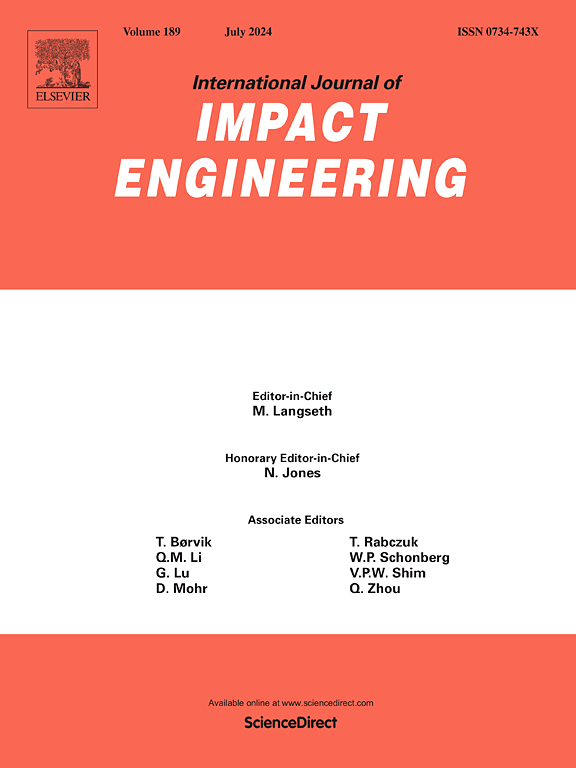在碎裂状态下对铝制威普尔防护罩的超高速撞击与系统参数变化:实验和数值研究
IF 5.1
2区 工程技术
Q1 ENGINEERING, MECHANICAL
International Journal of Impact Engineering
Pub Date : 2024-09-24
DOI:10.1016/j.ijimpeng.2024.105126
引用次数: 0
摘要
铝制惠普尔防护罩通常用于保护航天器免受来自轨道碎片和微流星体的超高速撞击(HVI)。由于数字模型如今在防护罩的设计过程中至关重要,因此对超高速撞击的实验研究对于确保数字方法的稳健性以及能够准确描述一系列撞击条件和材料响应非常重要。碎裂机制是弹道撞击和超高速撞击之间的过渡速度范围,通常定义为 3 至 7 千米/秒。在这一区域,撞击产生的碎片云从速度范围低端的几块大的固体碎片过渡到速度较高的大量较小碎片和弹丸的部分熔化。在本研究中,对球形 AA1100 弹丸对 AA6061-T6 Whipple 防护罩的 22 次正常撞击进行了实验,系统地改变了撞击速度和保险杠厚度,以研究碎片云特征和防护罩损坏的变化。研究了 2.6 至 5.0 千米/秒的撞击速度,以及 1.0、1.5 和 2.0 毫米的保险杠厚度。利用碎片云的高速摄像镜头以及保险杠和后壁的撞击后分析,对实验结果进行了分析。然后使用 IMPETUS 求解器中的平滑粒子流体力学 (SPH) 方法建立了一个数值模型,并将数值结果与实验数据进行了比较。模拟结果能够捕捉到实验研究中发现的主要趋势,并且在改变撞击速度和保险杠厚度时显示出与实验相似的损坏程度。与实验结果相比,模拟结果在碎片云中产生的碎片更小一些,因此对后壁造成的破坏也略小一些。本文章由计算机程序翻译,如有差异,请以英文原文为准。
Hypervelocity impact against aluminium Whipple shields in the shatter regime with systematic parameter variation: An experimental and numerical study
Aluminium Whipple shields are commonly used to protect spacecraft against hypervelocity impacts (HVIs) from orbital debris and micrometeoroids. Since numerical models nowadays are vital in the design process of protective shields, experimental studies of HVI are important to ensure that the numerical methods are robust and capable of accurately describing a range of impact conditions and material responses. The shatter regime is the transition velocity range between ballistic impact and hypervelocity impact, typically defined from 3 to 7 km/s. In this region, the debris cloud generated by the impact transitions from a few large, solid fragments at the lower end of the velocity range, to a high number of smaller fragments and partial melting of the projectile at the higher velocities. In this study, an experimental campaign of 22 normal impacts of spherical AA1100 projectiles on AA6061-T6 Whipple shields is performed, where the impact velocity and bumper thickness are systematically varied to study the change in debris cloud characteristics and shield damage. Impact velocities from 2.6 to 5.0 km/s are investigated, combined with bumper thicknesses of 1.0, 1.5 and 2.0 mm. Analysis of the experimental results is conducted using high-speed camera footage of the debris clouds and post-impact analysis of bumpers and rear walls. A numerical model is then established using the Smoothed Particle Hydrodynamics (SPH) method in the IMPETUS Solver, and the numerical results are compared to the experimental data. The simulations are able to capture the main trends found in the experimental study, and show a similar level of damage as the experiments when varying the impact velocity and bumper thickness. The simulations have somewhat smaller fragments generated in the debris cloud than in the experiments, leading to slightly less damage inflicted on the rear wall.
求助全文
通过发布文献求助,成功后即可免费获取论文全文。
去求助
来源期刊

International Journal of Impact Engineering
工程技术-工程:机械
CiteScore
8.70
自引率
13.70%
发文量
241
审稿时长
52 days
期刊介绍:
The International Journal of Impact Engineering, established in 1983 publishes original research findings related to the response of structures, components and materials subjected to impact, blast and high-rate loading. Areas relevant to the journal encompass the following general topics and those associated with them:
-Behaviour and failure of structures and materials under impact and blast loading
-Systems for protection and absorption of impact and blast loading
-Terminal ballistics
-Dynamic behaviour and failure of materials including plasticity and fracture
-Stress waves
-Structural crashworthiness
-High-rate mechanical and forming processes
-Impact, blast and high-rate loading/measurement techniques and their applications
 求助内容:
求助内容: 应助结果提醒方式:
应助结果提醒方式:


